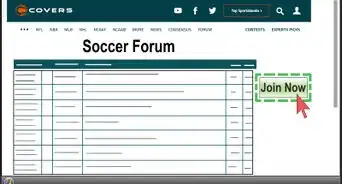This article was co-authored by wikiHow Staff. Our trained team of editors and researchers validate articles for accuracy and comprehensiveness. wikiHow's Content Management Team carefully monitors the work from our editorial staff to ensure that each article is backed by trusted research and meets our high quality standards.
There are 9 references cited in this article, which can be found at the bottom of the page.
This article has been viewed 343,947 times.
Learn more...
With the infinite fantasy resources available these days, getting ready for draft day can be a bit overwhelming. Starting your research early and being ready to pivot quickly can help you make smart picks in crunch time. That being said, your team’s roster isn’t set when the draft is over. Make sure to keep up to date with roster and injury news throughout the season. In many cases, the most prepared and well-read fantasy player is the most successful one.
Steps
Preparing for Your Draft
-
1Start your research early. No one wants to be the one scrambling on draft day. These days there are more fantasy resources than ever. Articles and rankings will start to pop up during the summer, so you can use these as a guide for what to look out for. Some pretty reliable resources are:
- ESPN
- Sports Illustrated
- CBS Sports
- Sporting News
- Fantasy Pros
-
2Research your league’s rules. Different leagues can have drastically different rules. Is your league a Point Per Reception (PPR) league? Are you allowed to have keepers from season to season?
- For a PPR league, you’ll want to target players who get a high amount of receptions over yardage. Keep an eye out for catch-first running backs.[1]
- A keeper league allows you to carry one or two players from season to season, so young superstars with high potential can anchor your team for seasons to come.
Advertisement -
3Look at mock drafts. Chances are most people in your league will be going off of an expert’s mock draft, so you’ll have a good idea when most players will get drafted. Studying a mock draft for potential sleepers (late-round players with a chance of outperforming their value) can pay dividends later in the season. Check out ESPN or CBS Sports for some helpful mock drafts.[2]
-
4Keep an eye on the Injury Reserve (IR). Season ending injuries occur often in the NFL, so watch for news regarding injuries closely. A handful of seemingly solid picks can develop nagging ailments during the preseason. No one wants to be the laughing stock of the draft room for taking a recently injured player.[3]
-
5Be ready to pivot. As mentioned earlier, things can change quickly in the NFL. Injuries develop and people lose starting jobs at the drop of a dime. Even though you may have researched heavily, don’t be tied to any of the players you admire. It’s always a good idea to have backup picks stashed.[4]
Drafting Your Team
-
1Take the best available player with your early picks. High-end running backs (RBs) and wide receivers (WRs) typically produce the most points, so it’s usually smart to pick them up early. Wait on balancing your positions until the middle rounds and focus on picking players who produce early. Don’t hesitate to take Antonio Brown and Odell Beckham Jr. (two great WRs) in the first two rounds if they’re the best available. It just means your team will have an unparalleled passing game.[5]
-
2Wait on drafting a quarterback until the middle or late rounds. The discrepancy between different tiers of QBs is much lower than that of RBs or WRs. While it may be tempting to take a big name, like Cam Newton or Tom Brady, you’ll be in much better shape filling out the rest of your roster with solid performers and picking up a mid-tier QB later on.[6]
-
3Pay attention to BYE weeks. Every NFL team has one off week during the season. While it’s totally fine to have a couple players out on the same weeks, you won’t want to end up with half your team missing a certain week.[7]
-
4Don’t draft all players from your favorite team. It’s always best to diversify your team so one bad loss doesn’t wreck your whole week. Try to keep it to two or three players from the same team at a maximum.[8]
-
5Don’t forget about “handcuff players.” These are the backup players that would take over in the event that your superstar early round pick gets injured. For example, picking up both Ezekiel Elliott and Darren McFadden will act as an insurance policy on Elliott. Someone will grab them in seconds if left on the waiver wire.[9]
-
6Wait on kickers and defense until the very end of your draft. Kicker and defense point totals can fluctuate heavily throughout the season, so it’s not worth it to use an early- or mid-round pick on one of these positions. They’re also typically low scorers that are hard to predict before the season begins, so there’s not much reward in picking up an elite kicker early.[10]
-
7Base your late round picks on touches and targets. In many cases, your last few picks of the draft won’t start a single game for you all season. Make sure to note late round players that have a history of getting ample pass targets and rush touches, rather than yardage and touchdowns. These can correlate to some cheap fantasy points.[11]
Managing Your Team Throughout the Season
-
1Check fantasy updates early and often. Big changes in a team’s starting lineup happen frequently in the NFL. In many cases, the person with the most fantasy success is the person staying most up to date. By checking for roster updates regularly, you’ll be able to pick up and drop players faster than others.
-
2Keep a close eye on the waiver wire. This is where players without fantasy teams end up. If a marquee RB or WR ends up injured, picking up their backup is usually a smart move. If they have had success, it’s usually because of a solid offensive line blocking or an experienced QB throwing to them. This can translate to decent numbers to fill in the gap in your roster.[12]
-
3Don’t be afraid to make a trade. Many unsuccessful teams become stagnant when their owner banks on one of the bench players starting to excel. If you’ve got two solid tight ends(TEs), but are lacking a good second RB, it’s usually safe to make a trade to balance your team. That being said, make sure to do ample research before accepting a trade. There could be a good reason your fellow league member is trying to get rid of that player.[13]
Community Q&A
-
QuestionWhere do I go online to draft my fantasy football team?
 Community AnswerThere are several sites, but you can check ESPN since it is free to host a fantasy football team.
Community AnswerThere are several sites, but you can check ESPN since it is free to host a fantasy football team. -
QuestionIn what round should I pick a QB?
 Community AnswerI've always taken a QB anywhere from the 3rd to the 5th round and it works well. But always pay attention to runs.
Community AnswerI've always taken a QB anywhere from the 3rd to the 5th round and it works well. But always pay attention to runs. -
QuestionIn what order do I include individual defensive players in the draft?
 Community AnswerDefensive players are picked by team. You do not pick individuals in my experience.
Community AnswerDefensive players are picked by team. You do not pick individuals in my experience.
References
- ↑ http://www.espn.com/fantasy/football/story/_/page/nfldk2k14pprstrategy/point-per-reception-ppr-league-strategy
- ↑ https://www.cbssports.com/fantasy/football/draft-prep/
- ↑ https://www.thefantasyfootballers.com/articles/fantasy-football-understanding-injury-designations/
- ↑ https://www.washingtonpost.com/news/sports/wp/2017/08/30/how-to-draft-a-winning-fantasy-football-team-in-six-easy-steps/?utm_term=.9071c18df9a8
- ↑ https://www.washingtonpost.com/news/sports/wp/2017/08/30/how-to-draft-a-winning-fantasy-football-team-in-six-easy-steps/?utm_term=.9071c18df9a8
- ↑ https://www.si.com/nfl/2017/08/22/fantasy-football-2017-strategy-advice-drafting-turn
- ↑ http://fantasysixpack.net/2017-fantasy-football-bye-week-draft-strategy/
- ↑ https://www.si.com/nfl/2017/08/24/fantasy-football-2017-10-tips-beginner-expert
- ↑ https://www.fantasypros.com/nfl/running-back-handcuffs.php
- ↑ https://www.si.com/nfl/2017/08/22/fantasy-football-2017-strategy-advice-drafting-turn
- ↑ https://www.si.com/nfl/2017/08/24/fantasy-football-2017-10-tips-beginner-expert
- ↑ https://www.sbnation.com/fantasy/2013/8/20/4620776/fantasy-football-101-managing-your-team
- ↑ https://www.sbnation.com/fantasy/2013/8/20/4620776/fantasy-football-101-managing-your-team
About This Article
Before you draft your fantasy football team, research players and rankings on websites like ESPN and Sporting News. When draft day arrives, take the best available players with your early picks, like high-end running backs and wide receivers, since they typically produce the most points. You should wait to draft your quarterback until the middle or late rounds, as their quality doesn’t vary as much as players in other positions. Then, draft your kickers and defense last, because they’re low scorers whose results are often hard to predict. For tips on how to manage your fantasy football team throughout the season, keep reading!

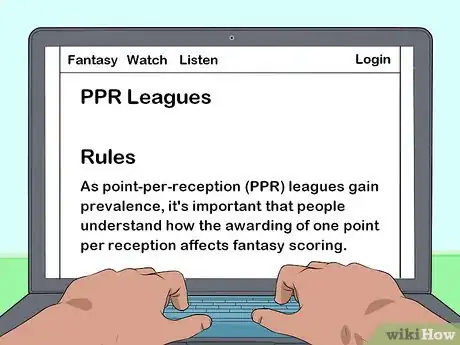



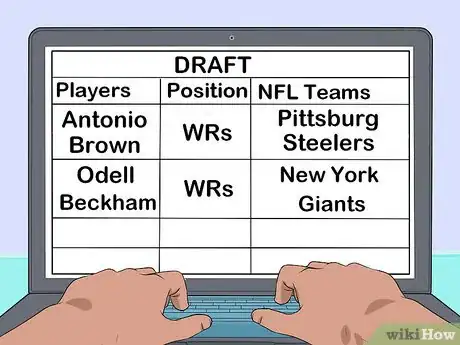


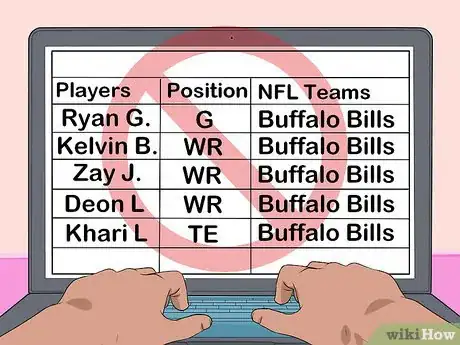



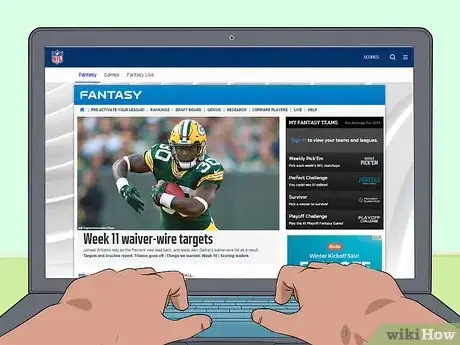
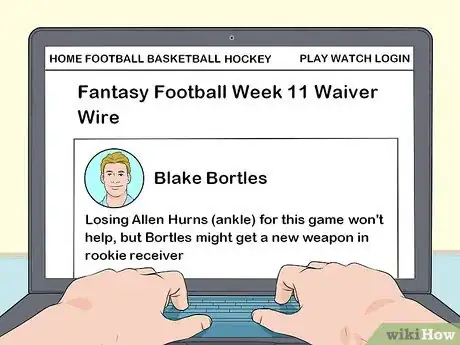





-Step-21.webp)

